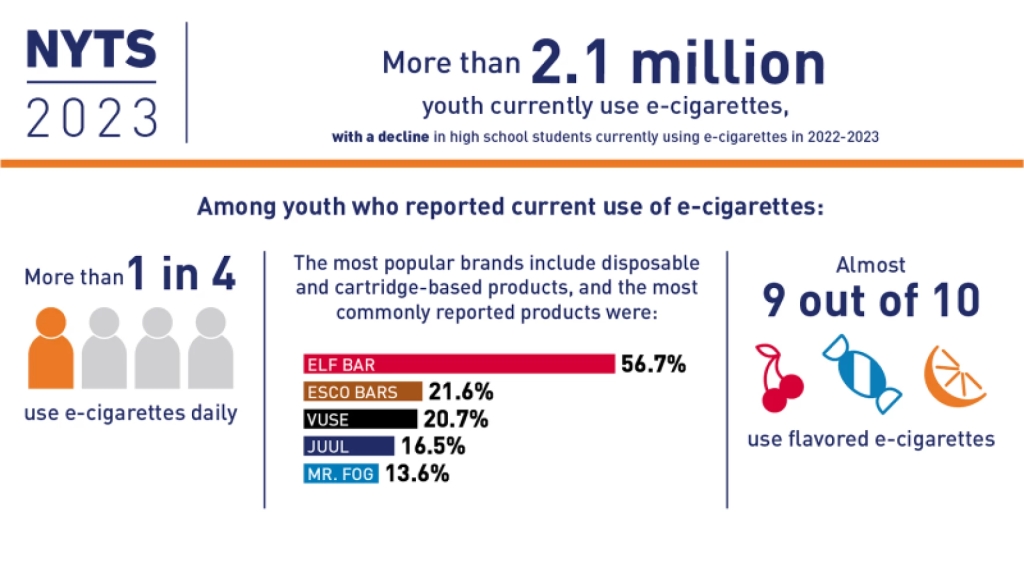In the latest 2023 data, a concerning reality surfaces: more than 2.1 million teens nationwide are currently using e-cigarettes, with a surprising 1 in 4 engaging in daily vaping, as reported by the FDA (FDA, 2023). In Michigan, around 14 percent of high school students are into electronic vapor products, slightly lower at 13.6 percent in Kent County (YRBSS and MiPHY).

Michigan’s Progress and Persistent Challenges
Although rates of high school students in Michigan who have ever used electronic vapor products decreased from 2019-2021, dropping from 50 percent to 33 percent, tobacco use is still the number one cause of preventable death in Michigan (YRBSS).
Health Impacts of Teen Tobacco Use
Through research, we know the impacts of tobacco use on health outcomes. These include an increased likelihood of nicotine addiction, effects on memory, mood, and attention, a higher risk of lung disease, and worsened symptoms for lung conditions like asthma. Higher levels of anxiety and depression, as well as an increased risk of severe burns and injury from devices, are all risk factors for tobacco use (YRBSS).
Using electronic vapor products, also referred to as vapes, e-cigs, vape pens, or mods, can be especially harmful to youth due to the high levels of nicotine present in these products (FDA, 2023).
Advocating for Change: Local and Statewide Initiatives
Local and statewide coalitions are working hard to protect our communities’ youth from harmful tobacco. In November 2023, Michigan Senators introduced bills aiming to halt the sale of nicotine or tobacco products, vapor items, and alternative nicotine products to minors. These bills could significantly change how youth access tobacco.
One of the bills in the package would cover a statewide ban on flavored products, which we know are highly marketed to and used among many young people. In 2023, the National Youth Tobacco Survey found that 89.4% of youth e-cigarette users use flavored products, with fruit flavors being the most popular (CDC, 2023). Another bill introduced in the package would create a required retail license to sell vaping nicotine products. This bill is vital as Michigan had one of the highest rates of selling tobacco products to kids last year (FDA, 2023).
Educators as Champions: Shaping a Healthier Tomorrow
As these bills go to the Senate for policy change, what actions can you take as an educator?
- At the system level, promoting smoke-free/tobacco-free policies in all places can help decrease youth initiation of tobacco products.
- At the classroom level, using evidence-based curriculum and prevention messages can significantly impact student behavior.
- Equipping students with the knowledge about the dangers of tobacco use and the skills for confident and effective communication with peers can help build a strong foundation. Using evidence-based curricula has been shown to decrease the likelihood of e-cigarette use, tobacco use, and more vital drug refusal skills (CATCH/ MMH/ Botvin).
There are a variety of substance use prevention education curricula available for students. Kent ISD offers free training for two highly effective options.
The first option, Michigan Model for Health, is an evidence-based pre-K through 12 health education curriculum. It includes lessons on substance use prevention at each grade (MMH, n.d.). Training sessions for Michigan Model for Health will be held on February 22nd or April 25th. For a free curriculum license, please reach out to Sarah Flinsky at Sarahflinsky@kentisd.org
The second option is a vaping-specific curriculum known as CATCH My Breath. This evidence-based program is explicitly designed for youth vaping prevention in grades 5-12. The training for CATCH My Breath is scheduled for February 6th.
Building a No-Tobacco Zone: Beyond Today’s Actions
In closing, the 2023 data highlights the pressing issue of teen tobacco use, with over 2.1 million youths nationwide entangled in e-cigarettes and a surprising 1 in 4 embracing daily vaping. Though Michigan’s high schoolers reduced e-cig use from 50 percent to 33 percent, tobacco still leads to preventable deaths. Implying a need for action, the broad health impacts range from increased nicotine addiction risks to intensified asthma symptoms. With local and statewide teams pushing for new laws, the Senate takes the spotlight. Holding some serious cards, educators can advocate for policy changes and deliver evidence-based lessons for a healthier tomorrow. This hustle for a no-tobacco zone is not just about what educators can do but the legacy we’re creating for generations.
Works Cited:
- U.S. Food and Drug Administration. “Help prevent sale of tobacco products to young people.” FDA, www.fda.gov/consumers/consumer-updates/help-fda-prevent-sale-tobacco-products-young-people.
- Centers for Disease Control and Prevention. “Youth Risk Behavior Surveillance System.” CDC, www.cdc.gov/healthyyouth/data/yrbs/index.htm.
- Michigan Model for Health. “About MMH Standards.” www.michiganmodelforhealth.org/about-mmh/standards-effectiveness.
- U.S. Food and Drug Administration. “Results of the Annual National Youth Tobacco Survey.” FDA, www.fda.gov/tobacco-products/youth-and-tobacco/results-annual-national-youth-tobacco-survey.
#YouthTobaccoPrevention #HealthyCommunities #PreventTeenVaping #EducationForChange #MichiganHealth #CATCHMyBreath #MichiganModelForHealth #TobaccoFreeYouth #KentISDpd #WeLeadLearning
This blog post was written by Sarah Flinsky, Health Education Consultant for Kent ISD and edited by Amanda Walma, T/L Marketing Specialist for Kent ISD.

